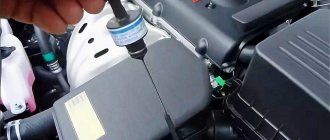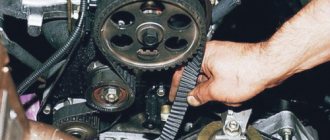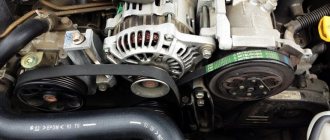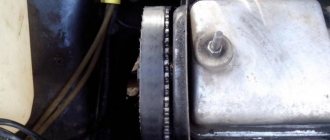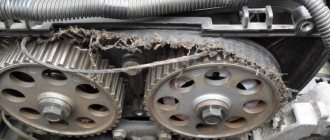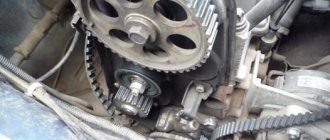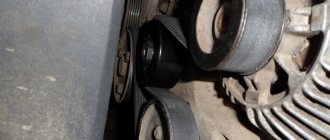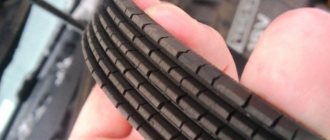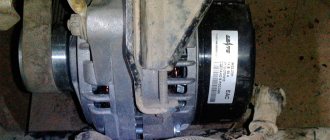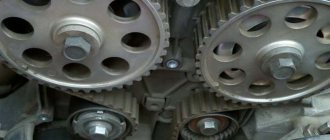01/26/2022 3,048 Timing belt, crankshaft and cylinder head
Author: Ivan Baranov
Replacing the timing belt is carried out depending on the degree of wear of this mechanism, the version of the car engine and the mileage of the vehicle. To carry out such a procedure yourself, you will need to have a minimum set of tools on hand and strictly follow the instructions.
[Hide]
After how many thousand kilometers does it need to be changed?
For each car, the frequency of replacing the timing belt is different, which can be found in the technical documentation of the car. On average, the belt is changed after a mileage of 50,000 km. If timing belts with reinforced metal cord are used, their service life is 30% longer than usual.
The mileage at which it is necessary to replace the timing belt is presented in the table:
| Vehicle conditions | Foreign production | Domestic production |
| New | 70-80 thousand km | 65 thousand km |
| Used | 60-70 thousand km | 50 thousand km |
How can you determine on your own when it’s time to change the belt?
When the timing of the last replacement of the timing belt is unknown, this part should be inspected for wear.
Signs indicating the need to replace the belt:
- oil leakage;
- damaged surface of the consumable;
- presence of bulges and uneven wear;
- worn teeth;
- cracks along the entire length of the belt;
- grooves on the teeth after starting the engine.
Signs of timing belt wear
When it is not possible to inspect the belt, you can be guided by characteristic signs of wear.
- When starting the engine, strong vibrations or a drop in thrust . This indicates that the belt is poorly tensioned or has slipped one or more teeth.
- Black smoke from the exhaust system. A worn belt is one possible cause.
- Fluid leaks near the drive. If technical fluids get on the belt, its service life is reduced.
It is not easy to determine the replacement of the timing belt; all symptoms may indicate other problems, but if they occur, do not delay in contacting specialists.
Consequences of a broken timing belt
For gasoline engines, the following consequences may occur after a belt breaks:
- Failure of all motor elements.
- The gas distribution mechanism may not even be suitable for repair. This can be caused by a strong impact of the pistons, after which the timing head is deformed.
- Damage to the cylinder block. Piston rings that have become unusable damage the mirror surface of the combustion chamber.
In diesel engines, a broken timing belt often leads to the following consequences:
- damage to camshaft bearings;
- deformation of piston connecting rods;
- broken intake valves.
The “Car Program” channel filmed the consequences of a broken timing belt.
Why is replacement needed?
If a rupture occurs due to untimely replacement, the consequences can be serious. At risk are power plants in which the pistons and valves are in the same block, because they do not meet each other only thanks to the timing belt, which acts as their synchronizer. When there is a gust, they continue to move by inertia, the pistons jump on the valves and bend them.
Since these are the most important parts, bent valves lead to a major overhaul of the engine, but not always everything is limited to this. There are other arrangements where the pistons and valves are spaced a little further apart and even a break does not lead to their meeting, but there are nuances here too. If the belt does break, this may lead to other problems:
- damage to the entire engine, it will simply stop starting;
- deformation of the gas distribution mechanism, up to unsuitability for repair;
- damage to camshaft bearings;
- wedge in the piston group.
Specific problems also depend on what speed was present at the time of the rupture and the model of the car.
Note!
You should not allow the consumable to fail; you should buy a new one in accordance with the manufacturer’s recommendations and signs indicating wear.
Recommendations for choosing a new timing belt
When choosing a strap, consider the following recommendations:
- Don't pay attention to cheap goods. If you use a low-quality or non-original part, engine repair will cost several times more.
- The belt must be elastic, and its surface must be smooth and without rubber deposits.
- The product number, number of teeth and length must match the old strap.
It is better to give preference to the following timing belt manufacturers: Contitech, Bosch, Dayco or Gates.
Preparing the machine and tools
Before you start work, you need to prepare everything you need in advance. This means stocking up on tools that may be needed, a new replacement kit, and also carrying out all the preparatory work.
First of all, prepare the place of work and the car itself:
- the working area must be level and normally lit;
- put the car on the parking brake;
- under the wheels - always stops;
- the engine must be completely cool;
- The car is de-energized and the battery terminals are removed.
Before starting to work on the engine itself, the car needs to be jacked up and everything that might interfere with getting to the timing belt must be removed.
List of necessary tools:
- standard set of open-end wrenches;
- a set of socket heads with a “ratchet”;
- fork key;
- a pair of screwdrivers (flat and Phillips);
- jack;
- sealant.
And finally, you need a new set of timing belt with rollers (its configuration depends on the car model), as well as clamps for the shafts (which ones depend on the engine itself, and this can be found in the service book), a flashlight, overalls, gloves and rags . And, of course, a phone with a camera, which will have to record the position of all the elements before they are dismantled. Believe me, this is important!
Replacing the timing belt
Replacing the timing belt includes several steps:
- Selecting the necessary tools.
- Preparatory work.
- Removing the old belt.
- Installing a new timing belt.
Selecting the necessary tools
To carry out work on replacing the timing belt, you must have the following tools:
- adjusting key for belt tension;
- open-end wrenches;
- set of hex bits;
- car jack;
- a spatula or large screwdriver.
Bit set
Special key for timing pulley
Mounting blade
Set of open-end wrenches
Preparatory work
Before changing the timing belt you need to:
- Place the car on a level surface in a garage or on an overpass.
- Apply the handbrake and place wheel chocks under the wheels.
- Lock the gear shift lever in the neutral position.
- Disconnect the battery terminal.
Removing the old belt
Removing the old timing belt is carried out according to the following algorithm:
- First, remove the belt drive protective cover using hex bits.
- The power circuit from the crankshaft sensor is turned off.
- Using an open-end wrench size 17, the generator pulley is removed.
- By turning the camshaft, the position of the shafts is set according to the marks (there are marks on the gas distribution mechanism drive that must coincide with the pulleys).
- Next, you need to loosen the tension roller using a special wrench and secure the flywheel with a powerful screwdriver or mounting spatula. The flywheel should also be aligned with the mark.
- Carefully remove the belt and check the tension roller for suitability.
Setting timing belt marks before replacement
Loosening the tension roller
Removing the strap
Installing a new timing belt
Installing the belt yourself is done in the following order:
- A new tension roller is installed.
- A new belt is pulled onto the crankshaft and camshaft without knocking off the marks.
- The belt is tensioned so that it can rotate no more than 90 degrees.
- The timing drive is manually turned clockwise.
- The marks are re-checked.
- Remove the screwdriver or spatula from the flywheel.
- The timing case is being installed.
- The terminals are connected to the battery.
- The engine starts.
What is a timing belt
Of course, the vast majority of motorists are aware that there is a timing belt in the car, what it is needed for and what the abbreviation means. If you are not already aware of this issue, this omission needs to be corrected immediately, filling the gap in the knowledge base of any driver. Knowing what a timing belt is in a car and when to replace it is the responsibility of every vehicle owner.
The timing belt is a gas distribution mechanism, which is an internal combustion engine device, whose purpose is to control the supply of the air-fuel mixture, and the dosing procedure is performed at certain time intervals.
The belt, made of high-quality reinforced rubber, is part of the gas distribution structure. It has an important role in ensuring synchronous operation of the crankshaft and camshaft. Thus, the timing belt determines the movement of the mechanism components and is a direct participant in the procedure for supplying fuel and exiting combustion products.
The coordinated functioning of the mechanism parts also determines the optimal operation of the vehicle’s power unit. The condition of the device affects the serviceability of the entire mechanism, and its replacement is strictly regulated by the automaker; a description is included in the vehicle’s operating instructions.
If during the period of car warranty service you don’t have to worry about the quality of the timing belt, especially since the manufacturer supplies the original part, then in the future, when purchasing a replacement part, you need to be especially careful and not try to save money by purchasing a low-quality product, because the functioning of the engine depends on it.
There are symbols on the timing belt, let's look at examples of translation of the decoding:
- 136-25.4 HNBR, where 136 is the number of teeth, 25.4 is the width of the belt, and HNBR is the material from which the part is made. This model is made of heat-resistant rubber that is resistant to ozone and chemicals, and also contains varying levels of acrylonitrile;
- ISO-58111x The first numbers (58) indicate the series of teeth, the next three indicate their number (111), the last value (19) indicates the width of the product in millimeters;
- 58127x3/4 HSN. The first digits are also the series number, the subsequent ones indicate the number of teeth, 3/4 is the width in inches (19 mm). The HSN marking stands for highly saturated nitrile, a modern belt material that is particularly durable.
Replacing the timing belt must be approached with all responsibility, since by ignoring the need for the procedure, you can bring a number of problems to your car and the quality of the purchase must be taken care of first of all. It is very important that the belt is original, so special attention should be paid to the manufacturer.
On some Japanese car models, the timing system is driven by a chain. If so, then there is no need to worry that the replacement date may be missed; the chain is replaced after 200,000-250,000 km. Well, the usual timing belt is most often replaced at each scheduled maintenance.
Checking the drive for replacement
Now that the importance of timely maintenance of the timing belt has been determined, it would not be amiss to consider the principles of checking it for the possibility of further functioning. Firstly, it is worth noting that drive replacement can be caused by either premature wear or scheduled drive maintenance. The timing belt replacement period is about 50-60,000 km. Here, it is important to make one reservation - the full service life of a high-quality belt drive is 70,000 km, however, to avoid unexpected breakage and similar breakdowns, it is better to replace the element in advance.
Premature drive upgrade may be required for one of the following reasons:
- the teeth have severe wear, so tensioning the belt cannot normalize its operation;
- there are cracks and chips on the drive;
- the timing belt or engine is being overhauled;
- and of course, the belt broke.
In order to minimize all possible risks of drive failure or valve wear due to incorrect timing, the latter must be carefully inspected every 10-15,000 kilometers. During the inspections, the need to replace all elements of the assembly and belt tension is checked. If there is one, be sure to carry out the necessary procedures. Do not forget that replacing the timing belt yourself is a much cheaper procedure than repairing valves or other engine components.
When is the timing belt replaced?
Answers to the question at what time the timing belt is changed are available in the instructions for the vehicle. First, you need to diagnose the condition of the belt after ten to twelve thousand kilometers, but at least once every 12 months.
- Tightening, tears, threads, delamination, and other signs of wear require immediate replacement of the part.
- After fifty thousand miles, the belt drive is replaced regardless of its appearance.
How to choose the right timing belt, which brand is better, what are the prices on the market?
On the one hand, the timing belt is a simple thing, so it won’t create any special problems when choosing. On the other hand, each engine model has its own, correct one, with special technical characteristics.
Therefore there are three options:
- Select by VIN code or technical data of the car. This is the most accurate method that all specialists use. It is especially relevant if you need not only a belt, but also the entire replacement kit.
- Select according to certain characteristics. That is, knowing the width and number of teeth, choose exactly the same one.
- Knowing the individual number (the one indicated by the manufacturer), choose the same one or an analogue (catalogues of analogues are available in any online store).
All three methods have the right to exist, but specialists mainly use the first and third, and ask for technical specifications only for verification.
In terms of brands, there are three categories of recommended brands:
- OEM, that is, belts with the brand of the automaker. This is an ideal, albeit the most expensive option, since their quality is almost the same as that of the factory ones. It runs quite well throughout the entire regulatory period and presents almost no unpleasant surprises (almost - because a defect can slip through even two or three stages of quality control, nothing can be done about it). OEM prices go up to $200 (per belt, not per set), but this is perhaps an extreme option. On Lada, for example, branded ones cost from 25 to 100 dollars.
- Premium brands are manufacturers who make spare parts to order from automobile concerns (that is, they produce OEM products) and release them under their own brand. The quality is high, reliability too, prices are lower than the original, but not by much. These are, for example, Contitech, Lemforder, Gates. Prices start from 10 and go up to the same 200 dollars.
- Mass market brands are those manufacturers that are in greatest demand. Prices are usually average, but the quality is quite decent. For example, the most popular brands among buyers are Bosch, Dayco, SKF and Blue Print, prices for which start from 5 and end at 100 dollars.
Do the rollers need to be changed at the same time as the belt? After all, the difference in price between a separate timing belt and a complete set is very, very noticeable, so is it worth the expense?
The answer to this question is very simple - the more fuss with replacement, the more arguments there are for replacing the entire set, including the water pump. The rollers wear out and begin to vibrate, this vibration shortens the service life of the belt itself. Even if you don’t change it yourself, but go to a service station, it’s still better to pay once for the work than twice with a short interval.
However, if the belt is replaced for any reason long before the end of its standard service life (for example, it was incorrectly installed and frayed, or was initially of very poor quality and quickly cracked), then it may be enough to replace only it, and not the whole set.
